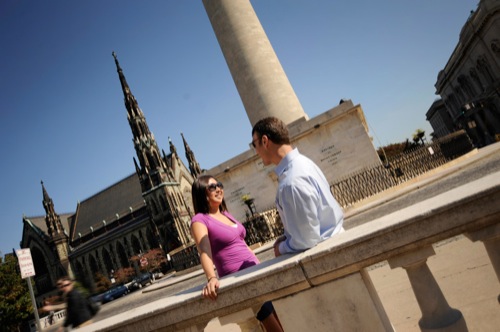
Sightseeing in the Mount Vernon neighborhoodA Place in History
While you’re exploring the historic side of Baltimore, consider visiting some of the city’s other excellent historic sites and museums that aren’t directly related to religious heritage.
Perhaps the most famous historic attraction is Fort McHenry National Monument and Historic Shrine. The harbor fortress played a role in several American wars but is best known for its role in the Battle of Baltimore during the War of 1812. It was from aboard a ship outside the fort that Francis Scott Key wrote the poem “The Star-Spangled Banner” during this battle, which took place in September 1814. The poem went on to become our national anthem, forever cementing Fort McHenry’s place in American history and culture.
Today, groups visiting Fort McHenry have a variety of options to learn about the site and its history. A new visitors center opened in 2012 has an introductory film and museum exhibits. During the summer, ranger talks take place daily, and the Fort McHenry Guard performs drill, musket and artillery demonstrations. Special events such as twilight tattoo ceremonies and historical commemorations also take place at the fort throughout the year.
If your group is fascinated by the story of “The Star-Spangled Banner,” you can take them to the museum and library of the Maryland Historical Society, where they can see the oldest surviving manuscript of Key’s poem. The gallery also has painting and artifacts that tell the story of the Battle of Baltimore, as well as a changing selection of historic sheet music related to the national anthem.
Beyond its military significance, Baltimore is an important place in African-American history, and a number of museums throughout the community explore that facet of the city’s past.
The Reginald F. Lewis Museum of Maryland African American History and Culture gives visitors a good overview of the importance of African-American contributions to the state. Established in honor of a successful Maryland businessman and philanthropist, the museum has three permanent exhibition galleries that focus on aspects of African-American history, among them slavery and survival, developing new trades and expression through the arts.
Escaped slave and early civil rights leader Frederick Douglass was born in Maryland and spent much of his early life working in Baltimore. Today, the Frederick Douglass-Isaac Myers Maritime Park tells the story of Douglass’ life in Baltimore as an enslaved child and young man, as well as the establishment of the African-American community in Baltimore during the 1800s.










